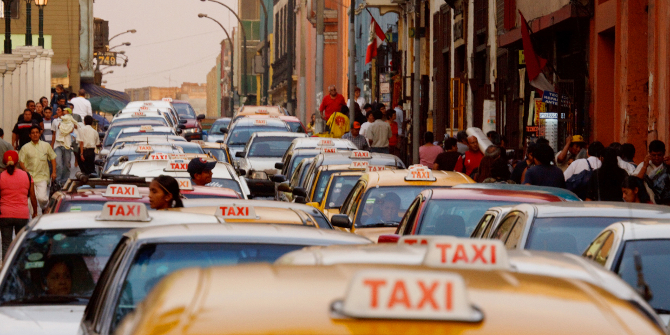
When anyone can be a taxi driver at any time and in any vehicle, apps like Uber, Taxi Beat, and Cabify provide a sense of transparency and accountability, as well as a degree of efficiency and formality for drivers. Any legislation should identify real problems and propose solutions for the wider industry, as well as for Peruvian public transport more broadly, writes Alonso Morán de Romaña.
As elsewhere around the world, Peru’s legislature has recently approved a bill to regulate transport apps such as Uber, Taxi Beat, and Cabify, essentially treating them as public transportation companies rather than digital “intermediaries” that connect drivers and passengers.
In Peru, however, public policy in the early 1990s encouraged low-income citizens to become drivers, and the taxi industry grew massively as part of the informal economy. Though less controversial and topical, the informal taxi sector is dogged by chaos and insecurity, making it unclear why transport apps are in greater need of regulation, especially when these appear to be solving some of the main problems with traditional taxis.

Facing new regulations
Transport apps may find it hard to adapt to new Peruvian legislation, which proposes important rules:
- the creation of a national registry of all transport apps
- traditional taxi-driver permits for every app-linked driver
- civil and criminal liability of apps vis-a-vis third parties
Although the proposed National Register for Transport Apps could be considered bureaucratic excess, it is the latter two rules that have proved most controversial.
Demanding that app-linked drivers be authorised by the same process as other taxi drivers will make many think twice, as most neither feel nor want the status of taxi drivers.
It is also debatable that apps should face liability to third parties for any damage, as they neither own the vehicles nor have any established employment relationship with the drivers, which is the modus operandi of most peer-to-peer transport apps – and indeed much of the sharing economy.
Meanwhile, other public transport services persist with little or no regulation, not to mention little incentive to self-regulate. Previous regulatory initiatives by local authorities have proved unsuccessful.
The taxi industry in Peru
Taxi services in Peru offer poor conditions. Taking a cab almost anywhere involves hailing at improvised stops, negotiating a price rather than using a meter or fee structure, and travelling in poorly maintained cars with unauthorised drivers.
One news outlet recently reported on a Peruvian taxi driver considered to be the “worst driver in the world”: aside from having 147 fines, 28 arrest warrants, and a revoked license, his car had no mirrors or lights and he was filmed routinely talking on his mobile phone while carrying passengers. But he was still working the streets of Lima.
According to the city council, Lima alone has 182,000 taxi drivers, of whom nearly 92,000 are informal and work without a permit. With around 9 million people living in Lima, this means there is roughly one taxi for every 50 inhabitants, which is nearly five times the average for Latin America’s main cities.

In practical terms, this also means that informal, unidentified taxi drivers are picking up children from school, tourists from airports, and people on nights out without any control from a national or even local transport authority.
The benefits of using a technological platform
For such reasons, Peruvians are increasingly using apps instead of hailing informal taxis in the street. According to a survey by Ipsos Peru in May 2017, 26% of taxi passengers use mobile applications, and this number has been rising every year.

One key reason is that apps feel safer, in a context where crime and transport are major issues (see above).
Traditional taxis often have informal drivers who are free from official oversight and passenger evaluations. Essentially, anyone can be a taxi driver at any time and in any vehicle. As such, taxis have frequently been used to commit crimes, from robbery to kidnapping, generating safety concerns. Apps, meanwhile, provide a sense of transparency and accountability, allowing passengers to identify the driver in advance and to view previous passenger ratings.
There are also benefits for drivers. App-linked drivers don’t have to drive around looking for passengers – wasting petrol and time in the process – because they receive alerts from potential customers nearby. They are also identified and registered by the app, so they are not entirely informal.
Considering the importance of transportation in people’s everyday existence, these benefits are effectively improving quality of life, safeguarding to some extent the right to safe and effective transportation.
In today’s context, where the public-transport system poses major challenges to the authorities, transport apps could actually have a positive effect, since they are starting to solve many longstanding problems in the taxi industry. As such, the advisability of introducing tougher regulations is doubtful, as it may increase the number of informal taxi drivers in the traditional industry while reducing the use of apps amongst both drivers and passengers.
Towards responsible regulation
Although the legislation proposed in Peru’s congress aims to protect app users, it needs to be evaluated via proper analysis and consideration. Regulation should address market failures and irregularities that require government intervention.
Here such market failures are not obvious, and legislation should first identify real problems, then propose solutions for the wider taxi industry, and indeed for Peruvian public transport more broadly. Regulators must also be careful not place undue limitations on the innovative digital ecosystem of Peru, which still has a long way to go in its promising expansion.
Notes:
• The views expressed here are of the authors rather than the Centre or the LSE
• Please read our Comments Policy before commenting






Unless the taxi industry starts innovating like Uber and Lyft it will be left behind since the customers will always choose the most flexible and cheapest option for transportation.